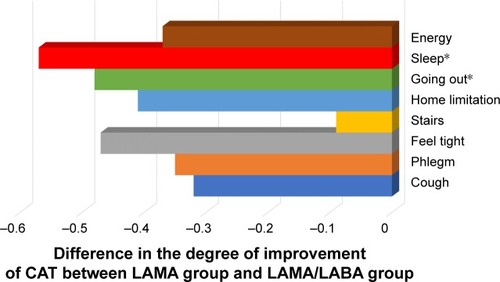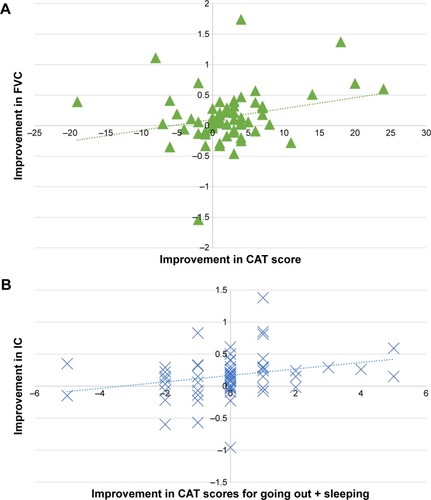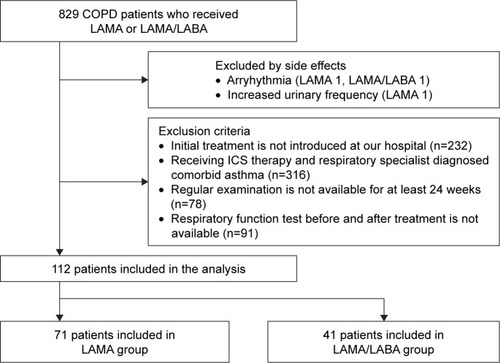Abstract
Background
A large body of evidence suggests that long-acting β2-adrenoceptor agonist (LABA)/long-acting muscarinic antagonist (LAMA) combinations induce a strong synergistic bronchodilatory effect in human isolated airways. Moreover, a recent post hoc analysis demonstrated clinical synergism between LABAs and LAMAs, which induces a synergistic improvement not only in lung function but also in dyspnea in COPD patients.
Aim
The aim of this study is to examine the baseline factors related to improvement in lung function or clinical symptoms that results from the administration of LAMA or LAMA/LABA and to compare the differences in improvement in lung function or clinical symptoms between LAMA and LAMA/LABA.
Methods
Among 829 patients with COPD who were treated with LAMA or LAMA/LABA in our hospital, 112 patients (aged 40–89 years) matched the criteria. Of these 112 patients, 71 received LAMA (LAMA group) and 41 received LAMA/LABA (LAMA/LABA group) as the initial treatment. Various examination results such as lung function test values, symptom change, and frequency of exacerbations were compared between the two groups.
Results
Compared with the monotherapy, the combination therapy significantly improved the FEV1, inspiratory capacity (IC), and total COPD assessment test (CAT) scores. Comparing the improvement in each domain of the CAT produced by the combination therapy with that of the monotherapy, larger improvements were found for the domains of going out and sleeping. The frequency of exacerbations during the 24 weeks was significantly lower in the combination therapy group than in the LAMA monotherapy group (P=0.034). Although no relationship was found between improvement in FEV1 and any pretreatment factors in the LAMA/LABA group, the improvement in the CAT score was strongly related to the baseline CAT score, smoking index, and air trapping index (P-value <1×10−4).
Conclusion
In this study of clinical practice, we found that LAMA/LABA combination therapy improved the clinical symptoms of COPD and IC and that the effects of the combination therapy were consistent with those observed in previous clinical trials.
Introduction
COPD is a lung disease characterized by persistent and incompletely reversible airflow limitation and is associated with an abnormal response of the lungs to noxious particles or gases. COPD is one of the most common respiratory diseases in older people, and the third cause of morbidity and mortality worldwide, with a high and growing prevalence.Citation1
Dual bronchodilator therapy is the cornerstone of COPD treatment.Citation2 A fixed-dose combination of an LABA and an LAMA improves lung function, dyspnea, quality of life, and exercise tolerance and reduces the risk of exacerbations of COPD, leading to unquestionable clinical benefits when compared with bronchodilator monotherapy.Citation3,Citation4 In the current strategies, treatment with single-agent bronchodilators is recommended for patients with milder disease and LABA/LAMA combination therapy for patients with moderate or more severe COPD.Citation5
The rationale for combining two bronchodilators with different mechanisms of action is to induce synergism in the therapeutic efficacy, reduce the overall risk of adverse events, and allow significant dose reductions for a given effect. In addition, the toxicities of the drugs should not overlap.Citation6 A large body of evidence suggests that LAMA/LABA combinations induce a strong synergistic broncho-dilatory effect in human isolated airways.Citation7,Citation8 Moreover, a recent post hoc analysis demonstrated clinical synergism between LABAs and LAMAs, which induces a synergistic improvement not only in lung function but also in dyspnea in COPD patients.Citation9
In the current study, we examined whether LAMA/LABA combination therapy in the actual clinical setting in Japan shows comparable efficacy with that found in clinical trials in non-Japanese populations. We compared improvements in lung function and clinical symptoms obtained with a single agent of LAMA with those obtained with a combination therapy of LAMA and LABA in patients with stage I–IV COPD.
Methods
Participants
We studied 829 patients with newly diagnosed COPD who initiated LAMA or LAMA/LABA treatment from 2011 to 2018 at our hospital (Hitachinaka General Hospital, Hitachinaka, Japan). They had never used bronchodilators before. Of those, 717 patients were excluded on the basis of the following criteria: 1) the treatment was interrupted owing to side effects (arrhythmia: LAMA 1, LAMA/LABA 1; increased urinary frequency: LAMA 1); 2) the initial treatment was not administered at our hospital (n=232); 3) ICS therapy was given during the observation period, and comorbid asthma was diagnosed by a respiratory specialist (n=316); 4) a regular examination was unavailable for at least 24 weeks (n=78); and 5) respiratory function testing was not available before and after treatment (n=91) (). Of the remaining 112 patients, aged 40–89 years, 71 received LAMA (tiotropium, n=65; glycopyrronium, n=2; and acridinium, n=4), and 41 received LAMA/LABA (tiotropium/indacaterol, n=5; tiotro-pium/olodaterol, n=29; and glycopyrronium/indacaterol, n=7) as the initial treatment. The study protocol was approved by the institutional review board of Hitachinaka General Hospital (No. 17-008). We obtained written informed consent from the patients, with the exception of patients who had already died or who had stopped visiting us for reasons such as transfers. All patient data were maintained with strict confidentiality; therefore, the institutional review board of Hitachinaka General Hospital waived informed consent from the deceased or transferred patients.
Lung function tests
Spirometry using an electronic spirometer was performed with the patient in standing position, and in accordance with the criteria established by the Japanese Respiratory Society (JRS).Citation10 None of the patients used bronchodilators before spirometry. The patients performed up to three forced expiratory maneuvers to obtain acceptable results. Well-trained respiratory technicians continuously monitored the spirom-etry procedure and reviewed the flow–volume curves to ensure adherence to the standards. Data for %FEV1, %FVC, IC, and FEV1/FVC were obtained from all the patients.
We compared the lung function before and after the LAMA or LAMA/LABA treatments. The “before treatment” lung function was measured 2 weeks before the treatment, and the “after treatment” lung function was measured 4–12 weeks after the treatment. Lung function values were measured 2–8 hours after the inhaled dose. The time points for the “before” and “after” treatment lung function measurements were identical for each patient. The inhalation technique for both treatments was confirmed to be appropriate.
COPD exacerbations
A COPD exacerbation was defined as one of the following: 1) addition of antibiotics with or without an antitussive expectorant within 24 weeks of the initial administration; 2) an unexpected consultation within 24 weeks of the initial administration; and 3) hospitalization due to a respiratory disease within 24 weeks of the initial administration.
COPD assessment test
COPD status was assessed using the CAT. The CAT is a disease-specific questionnaire to assess the health status of individuals with COPD. It consists of eight questions related to cough, expectoration, dyspnea, chest tightness, going up hills/stairs, confidence in leaving home, activity limitations at home, and levels of energy and one question assessing the impact of COPD on sleep. Each question is assessed on a five-point scale, providing a total score ranging from 0 (floor) to 40 (ceiling), with higher scores indicating a more severe impact of COPD on a patient’s life.Citation11,Citation12
Statistical analyses
The changes in lung function (VC, FVC, FEV1, IC) and CAT scores after 24 weeks of LAMA or LAMA/LABA treatment were assessed using Student’s t-test, and the frequencies of exacerbations during the 24 weeks of treatment were compared between LAMA and LAMA/LABA groups using Pearson’s chi-squared test. We used univariate and multivariate analyses to examine pretreatment factors related to improvements in FEV1 or CAT score obtained with LAMA or LAMA/LABA. The variables incorporated in these models were age at the beginning of treatment, pack years of smoking history, CAT scores, and lung function test values before treatment. The changes in every CAT domain obtained with the single LAMA treatment were compared with those obtained with the combined LAMA/LABA treatment using Student’s t-test. Lastly, we also examined the relationship between improvement in CAT scores and improvement in lung function measures.
Results
Patients’ characteristics
The patients’ demographics and characteristics are summa-rized in . No statistical difference was found in any factor between the two groups.
Table 1 Patients’ demographics and baseline characteristics
Comparison of therapeutic effects of LAMA and LAMA/LABA
A summary of the results is shown in . The FEV1 and IC were significantly improved by the combination therapy: IC was improved by 241 mL. Similarly, the CAT scores were significantly improved by the combination therapy (mean change =3). When we compared the therapeutic effects of the single therapy with those of the combination therapy for each of the eight domains of the CAT, although no significant differences were found for cough and sputum, the domains of going out and sleeping were significantly improved by the combination therapy (). In the LAMA group, nine of the 71 patients had exacerbations, and in the LAMA/LABA group, one of the 41 patients had exacerbations during the 24 weeks. The frequency of exacerbations was significantly lower in the combination therapy group (P=0.034, one-sided Pearson’s chi-squared test; ).
Table 2 Therapeutic effects in the LAMA group and the LAMA/LABA group
Table 3 Number of exacerbations in the LAMA and LAMA/LABA groups
Figure 2 Comparisons of improvement in each domain of CAT between the LAMA/LABA and LAMA groups.
Abbreviations: CAT, COPD assessment test; LABA, long-acting β2-adrenoceptor agonist; LAMA, long-acting muscarinic antagonist.

Relationship between pretreatment factors and therapeutic effects
The relationship between all the pretreatment factors (age, pack years, CAT, VC, FVC, %VC, %FVC, FEV1, %FEV1, FEV1/FVC, IC, air trapping index) and therapeutic effects was analyzed by univariate analysis (). In the LAMA group, improvements in IC and baseline FEV1 were related, but IC was not related to any other factors including the baseline CAT score. Multivariate stepwise analysis revealed no significant relationships between the pretreatment factors and the therapeutic effects in the LAMA group.
Table 4 Relationships between pretreatment factors and therapeutic effects (univariate analysis)
In the LAMA/LABA group, although no relationship was found between improvement in FEV1 and any pretreatment factors, the improvement in the CAT score was strongly related to the baseline CAT score, smoking index, and air trapping index ( and ). In addition, we found that improvement in FVC was significantly related to improvement in the total CAT score (; ). The improvement in IC was significantly related to the improvement in CAT scores for the going out and sleeping domains (; ).
Table 5 Relationships between pretreatment factors and therapeutic effects (multivariate analysis)
Table 6 Relationship between improvements in CAT scores and lung functions
Figure 3 (A) Relationship between improvement in FVC and improvement in total CAT score in 63 COPD patients with CAT data. (B) Relationship between improvement in IC and improvement in CAT scores for going out + sleeping in 63 COPD patients.

Discussion
In this study of clinical practice in Japan, LAMA/LABA combination therapy showed greater effect on lung function, clinical symptoms, and exacerbations in patients with COPD (stages I–IV). With the LAMA/LABA combination therapy, improvement in the CAT score was obvious in patients with elevated baseline air trapping index and CAT scores. Furthermore, our findings indicated that improvement in IC may have led to the improvement in the CAT scores for the going out and sleeping domains.
The Nippon COPD Epidemiology (NICE) study (N=2,343) demonstrated that the prevalence of COPD in Japan is comparable to that in other developed countries.Citation13 Several studies have compared the effects of a single LAMA agent with those of an LAMA/LABA combination on FEV1,Citation14,Citation15 clinical symptoms assessed using the Transition Dyspnea Index and the St George’s Respiratory Questionnaire,Citation16 and exacerbationsCitation17 in COPD patients. All of those studies reported that the combination therapy was superior to the single-agent therapy and that the combination therapy had no medication side effects. Our current findings are consistent with those observed in previous clinical trials.
According to the recently modified GOLD guidelines,Citation5 the presence of airflow limitation is used as a diagnostic criterion, but symptom intensities and exacerbations are considered to be more important in the selection of treatment strategies. If the clinical score such as the CAT score is high or exacerbation is frequent, use of stronger bronchodilators is recommended. In this study, the baseline FEV1 did not predict improvement in clinical symptoms, and even among the COPD patients with milder airflow limitation, those with higher CAT scores at baseline seemed to have benefited from the combination therapy.
Limitations
This study was limited by its retrospective nature and the fact that the patients were not randomly assigned to the treatments. Furthermore, we could not perform uniform guidance of the inhalation technique, and there were periods during which only LAMA could be prescribed.
Conclusion
The present study found that LAMA/LABA combination improved the clinical symptoms of COPD and IC and that the effects of the combination therapy were consistent with those observed in previous clinical trials. In the future, randomized clinical trials may reveal the significance of LAMA/LABA combination therapy even in COPD patients with milder severity.
Abbreviations
| CAT | = | COPD assessment test |
| IC | = | inspiratory capacity |
| ICS | = | inhaled corticosteroid |
| LABA | = | long-acting β2-adrenoceptor agonist |
| LAMA | = | long-acting muscarinic antagonist |
| VC | = | vital capacity |
Acknowledgments
The authors thank Ms F Miyamasu, Medical English Communications Center, University of Tsukuba, for grammatical revision of the paper.
Disclosure
HY has received lecture fees from Boehringer Ingelheim. NHiz has received lecture fees from AstraZeneca, Astellas Pharma, and Boehringer Ingelheim. NHid has no conflicts of interest in this work.
References
- JiangZKnudsenNHWangGGenetic control of fatty acid β-oxidation in chronic obstructive pulmonary diseaseAm J Respir Cell Mol Biol201756673874828199134
- CalzettaLRoglianiPFaccioloFRendinaECazzolaMMateraMGPharmacological characterization of the interaction between umecli-dinium and vilanterol in human bronchiEur J Pharmacol201781214715428716723
- CalzettaLOraJCavalliFRoglianiPO’DonnellDECazzolaMImpact of LABA/LAMA combination on exercise endurance and lung hyperinflation in COPD: a pair-wise and network meta-analysisRespir Med201712918919828732830
- CalzettaLRoglianiPMateraMGCazzolaMA systematic review with meta-analysis of dual bronchodilation with LAMA/LABA for the treatment of stable COPDChest201614951181119626923629
- Global Initiative for Chronic Obstructive Lung DiseaseGlobal Strategy for the Diagnosis, Management, and Prevention of Chronic Obstructive Pulmonary DiseaseBethesda, MDGOLD2017
- ChouTCTheoretical basis, experimental design, and computerized simulation of synergism and antagonism in drug combination studiesPharmacol Rev200658362168116968952
- CazzolaMCalzettaLPageCPPharmacological characterization of the interaction between aclidinium bromide and formoterol fumarate on human isolated bronchiEur J Pharmacol201474513514325446566
- CazzolaMCalzettaLPuxedduEPharmacological characterisation of the interaction between glycopyrronium bromide and indacaterol fumarate in human isolated bronchi, small airways and bronchial epithelial cellsRespir Res20161717027296533
- RoglianiPCalzettaLOraJPuxedduECazzolaMMateraMGClinical synergism of LABA/LAMA combinations in COPD patientsPresented at: ERS CongressSeptember 11, 2017Milan
- Guideline of respiratory function tests-spirometry, flow-volume curve, diffusion capacity of the lungNihon Kokyuki Gakkai Zasshi2004Suppl156
- JonesPWBrusselleGdal NegroRWProperties of the COPD assessment test in a cross-sectional European studyEur Respir J2011381293521565915
- JonesPWHardingGBerryPWiklundIChenWHKline LeidyNDevelopment and first validation of the COPD Assessment TestEur Respir J200934364865419720809
- FukuchiYNishimuraMIchinoseMCOPD in Japan: the Nippon COPD Epidemiology studyRespirology20049445846515612956
- VinckenWAumannJChenHHenleyMMcbryanDGoyalPEfficacy and safety of coadministration of once-daily indacaterol and glycopyrronium versus indacaterol alone in COPD patients: the GLOW6 studyInt J Chron Obstruct Pulmon Dis20149921522824596459
- BeehKMWestermanJKirstenAMThe 24-h lung-function profile of once-daily tiotropium and olodaterol fixed-dose combination in chronic obstructive pulmonary diseasePulm Pharmacol Ther201532535925956072
- BuhlRMaltaisFAbrahamsRTiotropium and olodaterol fixed-dose combination versus mono-components in COPD (GOLD 2–4)Eur Respir J201545496997925573406
- CalverleyPMAAnzuetoARCarterKTiotropium and olodaterol in the prevention of chronic obstructive pulmonary disease exacerbations (DYNAGITO): a double-blind, randomised, parallel-group, active-controlled trialLancet Respir Med20186533734429605624

